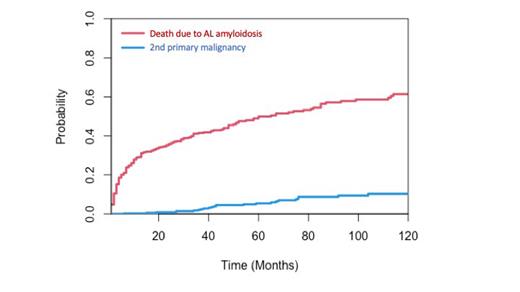AL amyloidosis is a clonal disease, characterized by the production of light chains from a usually small or modest in size plasma or B-cell clone. Early mortality due to severe organ involvement is the most ominous complication, long term sequalae, associated with organ involvement resulting in end stage dysfunction occurs but other long-term complications due to therapy or immunosuppression are often neglected. The treatment of AL amyloidosis is based on the elimination of the clone with the use of chemotherapy (including high dose melphalan) or immunochemotherapy. Among patients (pts) with myeloma or other B-cell malignancies the development of 2 nd primary cancers is a well described complication, associated with longer survival, exposure to multiple drugs and long-standing immunosuppression. However, data on the incidence and risk factors for second malignancies are not available for pts with AL amyloidosis. Thus, the aim of our study was to describe the incidence and risk factors for the development of 2nd malignancies among consecutive pts with AL amyloidosis.
The analysis included 417 consecutive pts, treated and followed in the Department of Clinical Therapeutics, Athens. The analysis accounted for death due to AL amyloidosis and diagnosis of 2 nd malignancy as competing events (competing risks analysis). The median age of the cohort was 65 years, 56% were females; heart, renal and liver involvement were present in 76%, 65% and 19% respectively. Per Mayo staging, 16%, 44% and 40 were stage -1, -2 and -3. Treatment, across all lines, included alkylators in 75% (mostly cyclophosphamide, melphalan was given in 21%, of which 5% as high dose), lenalidomide in 36% and daratumumab 31% while 95% had received bortezomib. The median follow up of the cohort was 56 months and the estimated median overall survival of all pts was 57 months. A second primary malignancy, after the diagnosis of AL amyloidosis, was diagnosed in 26 (6.2%) pts; these included breast (4 pts), renal (4 pts), colon (3 pts), lung (3 pts), gastric (2 pts), MDS (2 pts) and one case each from AML, ovarian, pancreatic, urothelial, sarcoma, head& neck cancers while two pts had multiple 2 nd cancers. The median age of the affected pts was 66 years and 13 (50%) were males; 29% had Mayo stage-1 disease, 52% had stage -2 and 19% stage 3 disease at initial diagnosis of AL amyloidosis. Accounting for death due to amyloidosis as a competing event, the cumulative incidence of 2nd primary malignancy was 0.7% at 2 years, 2% at 3 years, 4.5% at 4 years, 5.4% at 5 years, 7% at 6 years, 8.7% at 7 years and 10.25% at 10 years (figure 1). We then performed competing event univariate analysis to evaluate the potential association of several clinical, laboratory and treatment characteristics with the probability of developing a 2 nd malignancy. Notably, there was no increased risk of a 2 nd malignancy associated with the use of alkylators (either cyclophosphamide or melphalan), or melphalan (standard or high dose), lenalidomide or daratumumab. Since 95% of ptshad been exposed to bortezomib we could not make a meaningful analysis for this drug. Among baseline clinical characteristics, the presence of purpura or liver involvement (and with a trend for heart involvement) was associated with lower probability of diagnosis of a 2 nd malignancy, in the competing risk analysis. However, when analyzing the cumulative incidence of a 2 nd malignancy in ptswith different stages per Mayo system (1 vs 2 vs 3), the 5-year cumulative probability of death among pts with stage 1 disease per Mayo 2004, was 10.5% and the 5-year cumulative probability of 2 nd malignancy was 8.9% (the respective 5-year probabilities for Mayo stage 2 were 50.2% and 5.4% and for Mayo stage 3 were 69.7% and 3.7%). Thus, 2 nd cancers seem to affect mainly those with Mayo stage 1 discase, which also have the highest probability of long term survival. The 2 nd cancer was the cause of death in 10/26 (38%) of the affected pts.
In conclusion, second primary malignancies occur in 6% of pts with AL amyloidosis, affecting mostly pts without or with early cardiac involvement who have also the longest survival probability, with a 5-year cumulative risk of 9%. Second hematologic malignancies are uncommon (0.7%). We did not find a significant correlation with the use of alkylators of other specific agents. This data emphasizes the need for screening for the most common malignancies among pts with AL amyloidosis as new therapies improve the long-term survival.
Disclosures
Kastritis:Pfizer: Honoraria, Research Funding; GSK: Honoraria, Research Funding; Janssen: Honoraria, Research Funding; Sanofi: Honoraria. Migkou:Integris Pharma: Honoraria; Glaxo Smith Klein: Honoraria; Janssen-Cilag: Honoraria. Gavriatopoulou:Karyopharm: Honoraria, Research Funding; Celgene/Genesis: Honoraria; Takeda: Honoraria, Membership on an entity's Board of Directors or advisory committees; Sanofi: Honoraria; Amgen: Honoraria, Membership on an entity's Board of Directors or advisory committees; Janssen: Honoraria, Membership on an entity's Board of Directors or advisory committees; GSK: Honoraria; X4 Pharmaceuticals: Research Funding. Terpos:Janssen: Honoraria, Research Funding; ASTRA/Zeneca: Honoraria, Other: Travel Expenses; BMS: Honoraria; Amgen: Honoraria, Other: Travel Expenses, Research Funding; EUSA Pharma: Honoraria, Other: Travel expenses; Takeda: Honoraria, Other: Travel expenses, Research Funding; Sanofi: Honoraria, Other: Travel expenses, Research Funding; Pfizer: Honoraria; GSK: Honoraria, Research Funding; Menarini/Stemline: Honoraria.


